Quality of the Environment in Japan 1994
(12) Activities Based on the Japan-Republic of Korea Scientific and Technological Cooperation Agreement
On the basis of the Japan-Republic of Korea Scientific and Technological Cooperation Agreement, the Seventh Japan-Republic of Korea Scientific and Technological Cooperation Committee met in Seoul in March 1994. Agreements were reached on the continuation of existing programs, such as the Establishment of a Climatic Change Monitoring System in the Northeast Asia Region, and the implementation of new programs, such as the Fundamental Research Concerning the Movement and Circulation of Pollutants in Coastal Areas.
(13) Major Activities Based on Science and Technology Agreements with Other Countries
Based on the Japan-Canada Science and Technology Agreement signed in 1986, four Joint Committee Meetings have been held to date, and cooperation in the environment area is currently in process.
In February 1993, the First Joint Committee Meeting based on the Japan-Soviet Science and Technology Agreement signed in 1973 was held. Cooperation on projects, such as Reconstruction of Global Environmental Changes in Lake Baikal, are currently in progress.
12-4 Environmental Cooperation with Developing Countries
Developing countries are facing such problems as decline in forests and in other vegetation, soil erosion and salt damage, drying up of water sources, progressive desertification, destruction of natural resources including wildlife, and other issues. In the cities, especially, populations are growing and becoming more concentrated and the number of automobiles is increasing rapidly ; these developments are contributing to urban pollution problems. Furthermore, rapid industrialization is causing environmental pollution and destruction of nature even faster than that experienced in Japan during its years of acute economic growth. In addition to these conventional issues, developing countries have to cope with global environmental problems, including the ozone layer depletion and global warming. However, the countries facing these problems cannot adopt appropriate remedial measures due to the lack of funds, technology, personnel, and other resources. Hence, assistance from developed countries is essential. Support must also be provided to the East European countries where environmental measures have been insufficient arid serious pollution problems have occurred.
In the Agenda 21 adopted at the Earth Summit in June 1992, agreements were reached on technology transfer, improvements in the Global Environment Facility (GEF), and other functions, and reinforcement of support to developing nations. The Prime Minister announced Japan's intention to make contributions to the global efforts by increasing its Official Development Assistance (ODA) for environmental programs from ¥900 billion to ¥1 trillion during the five-year period from FY1992. This increase was intended to reinforce assistance to developing nations in implementing environmental conservation programs. In the first year of this five-year plan, 1992, Japan contributed ¥280 billion.
On June 30, 1992, Japan's Official Development Assistance Charter was decided by the Cabinet as a guideline of Japan's Official Development Assistance. The Charter states that environmental conservation is one of the fundamental principles of Japan's Official Development Assistance, and that Japan will provide support to supplement self-help efforts of developing countries to contribute to realizing sustainable development at the global level. To this end, these policies are being realized through stepped-up efforts to conduct discussions with developing countries and to explore feasible and promising projects.
Furthermore, the Basic Environment Law states in chapter 2, section 6 that Japan must implement necessary measures to promote international cooperation and adopt other measures concerning global environmental conservationIn fiscal 1993, Japan provided the following environmental cooperation.
12-4-1 Official Development Assistance
(1) Surveys and Identification of Projects
In expanding and stepping up assistance in the environment area, Japan has continued efforts to accurately evaluate the state of environmental problems in developing countries and the socioeconomic conditions constituting their backgrounds, while conducting intensive policy discussions with the governments of the developing countries to identify feasible and priority projects to be undertaken. To this end, environmen-tal missions were sent from Japan to Brazil, Mexico, and Southeast Asia in 1989 ; to East Africa in 1991 ; and to India in 1993. The missions engaged in intensive discussions regarding Official Development Assistance with the respective governments and related institutions as well as with aid-related institutions. On the other hand, the Japan International Cooperation Agency (JICA) is actively promoting various research and surveys with the cooperation of related ministries and agencies to develop individual projects.
Table 12-4-1 Development Studies
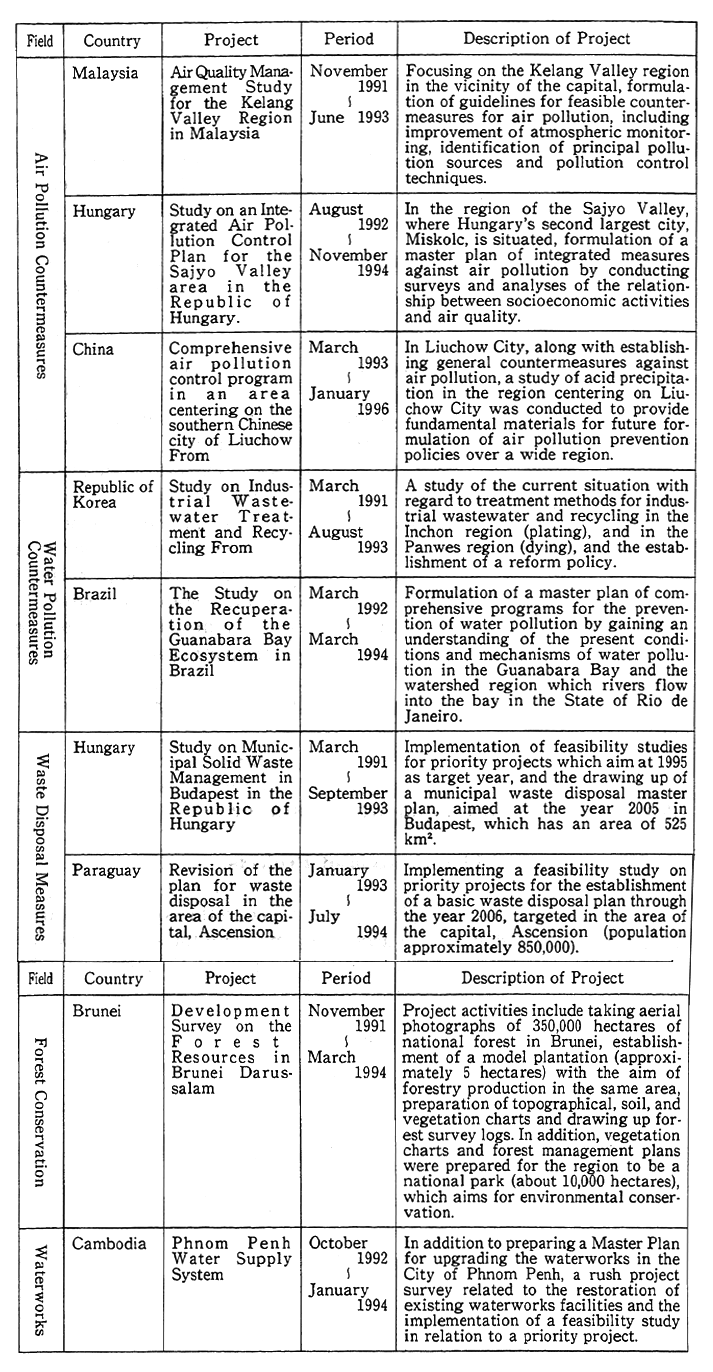
(2) Development Studies
Major development studies projects conducted by the Japan International Cooperation Agency in fiscal 1993 to formulate master plans concerning environmental problems in developing countries are shown in Table 12-4-1.
(3) Dispatching of Experts
To provide technical cooperation to governmental institutions and research institutions in developing countries, JICA has dispatched experts with the cooperation of ministries and agencies concerned and local public bodies. The number of experts dispatched for environmental conservation matter has increased dramatically, and the Environ-ment Agency, for example, participated in the dispatching 81 experts to countries such as Thailand, the People's Republic of China, Indonesia, and the Republic of Korea, and other nations (Figure 12-4-1). Since the demand for experts in the environmental conservation-related areas to dispatch overseas has risen so sharply, obtaining and training personnel is presently a major problem. JICA, the ministries and agencies concerned, and the related organizations are reinforcing training programs and have prepared list of available personnel to insure appropriate dispatching, as well as strengthening ties with the local governments.
Fig. 12-4-1 Number of Environmental Conservation Experts Dispatched
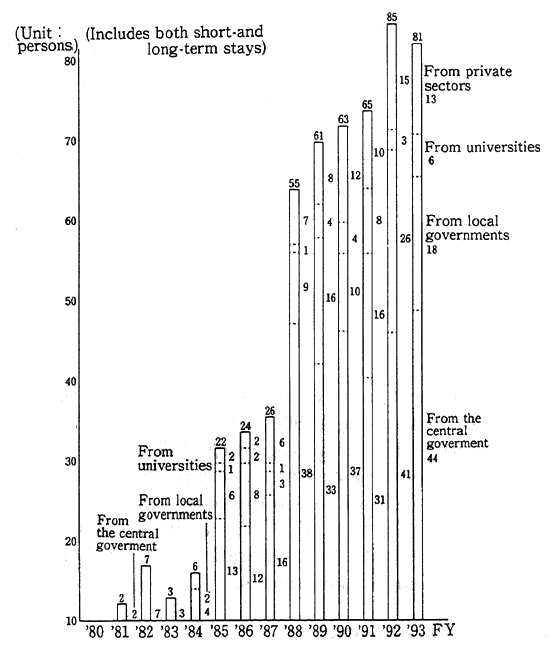
Dispatched Experts in the environmental sector (recommended by the Environment Agency)
Table 12-4-2 Group Training in Environmental Fields

Table 12-4-3 Acceptance of Individual Trainees in Environmental Fields

(4) Acceptance of Trainees
Many developing countries face a shortage of bureaucrats and engineers with specialized knowledge in environmental conservation issues as a whole. JICA provides group training programs to these countries with the cooperation of the ministries and agencies concerned, local governments, and other institutions. In fiscal 1993, group training programs were implemented in environmental policy making, environmental engineering (water quality conservation), environmental engineering (atmospheric conservation), and other areas. Special training programs for specific countries were provided to East European countries and Brazil. Special Individual Training Programs are also available on request by developing countries. (Tables 12-4-2 and 12-4-3)
(5) Project-Type Technical Cooperation
Project-type technical cooperation combines the dispatching of experts and the accepting of trainees and other means. This type of cooperation is conducted by JICA with the cooperation of ministries and agencies concerned. The major projects currently being implemented are as shown in Table 12-4-4. For projects that have been concluded, follow-up cooperation is provided accordingly.
In response to new requests for the project-type technical cooperation, preliminary inspection teams were dispatched to install environment centers in Mexico and Chile, and a basic study team was dispatched for the Indonesia Biodiversity Conservation Project.
(6) Roles of Local Governments and Other Institutions
Local governments and other institutions have enough experience and many experts in the field of environment. They therefore can play an important role in the dispatching of specialists and acceptance of trainees. In fiscal 1993, a total of 18 specialists from local governments were dispatched through JICA and types of assistance were provided. Local governments are also promoting original environmental cooperation with sister cities, such as accepting trainees, sponsoring conferences, and exchanging information.
Table 12-4-4 Major Project-Type Technical Cooperations
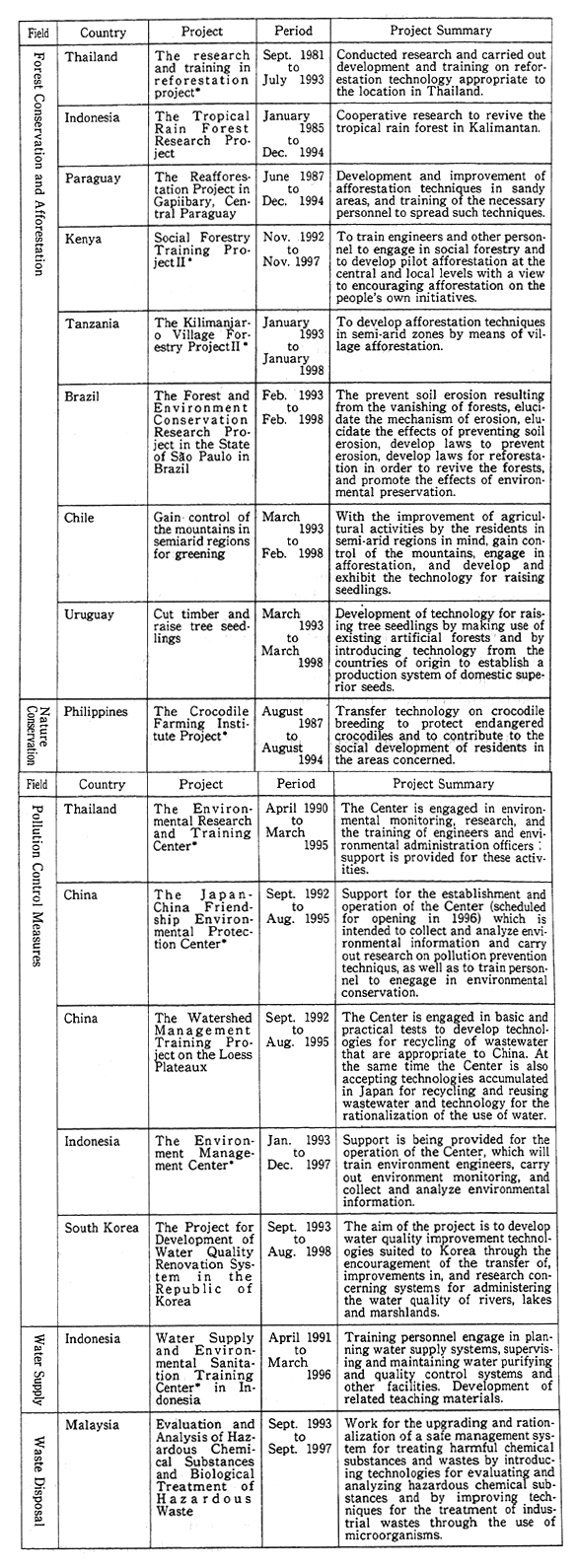
(7) Cooperation Through Grant Aid
Grant Aid was provided together with project-type technical cooperation to construct and manage various types of facilities as shown in Table 12-4-5.
Table 12-4-5 Major Grant Aid Cooperation Projects in Environment Fields
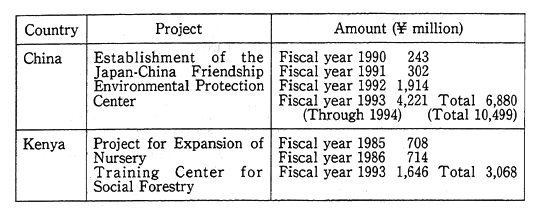
Remark : Fiscal years are the dates when the official agreements were exchanged.
(8) Cooperation Through Loans
As Japan experienced at first hand during the period of reconstruction after World War II, loans provide support for infrastructure projects and are highly effective in supporting efforts by developing countries to promote sustainable development.
It is the same in the environmental conservation related fields. Japan actively provides loans for use in environmental conservation related fields through the OECF.
Major areas eligible for this support are those too large in scale to be funded by grant aid, such as sewerage and household water construction projects, afforestation, and countermeasures against atmospheric pollution.
Table 12-4-6 Major Loans in Environmental Projects
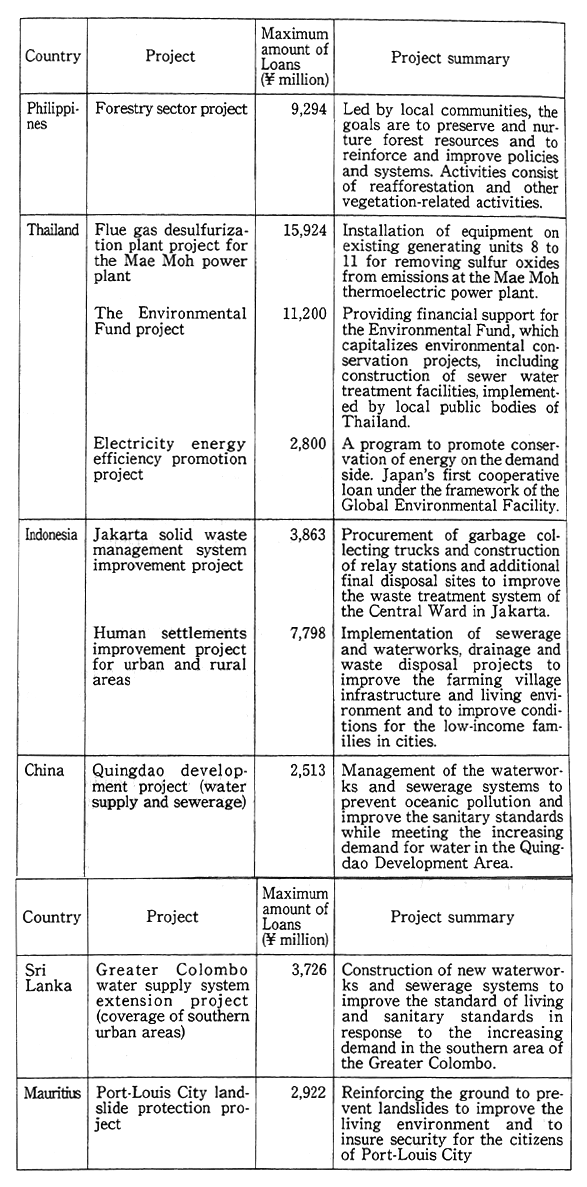
Remark : Fiscal years are the dates when the official agreements were exchanged.
As shown in Table 12-4-6, loans were provided to Thailand for its project to install a desulfurization facility for a thermal power station and other environmental conservation-related projects through the OECF.
(9) Basic Surveys and Other Activities
Ministries and agencies concerned.conducted a number of surveys and carried out other activities related to the environrnental problems of developing countries and the background of such problems to implement the above mentioned projects smoothly.
(lO) Cooperation Through International Institutions
Cooperation through international institutions is necessary in cases where bilateral cooperation is insufficient, such as in addressing global environmental issues, developing guidelines for common efforts. and promoting efforts in countries and areas where available information is scarce.
In fiscal 1993. Japan contributed a total of ¥244 million to the United Nations Environment Plan (UNEP). for its United Nations Environment Fund and Technical Cooperation Trust Fund for UNEP's International Environmental Cooperation Center, since it plays a central role in environmental issues. Japan also contributed ¥1.645 million to the International Tropical Timber Organization for conservation and sustainable utilization of tropical rain forests. Multinational aid organizations where Japan is the main contributor such as the United Nations Development Program (UNDP), the World Bank, the Asian Development Bank, and other organizations are increasing their contributions for the environmental field. Cooperation through these organizations is also becoming more and more vital in the environmental field.
The Global Environment Facility. (GEF) was established through the cooperation of the World Bank, UNDP and UNEP in 1991 as a pilot program to provide funds for efforts in developing countries to arrest global warming, stem the decrease in biodiversity, prevent worsening of the environment in international waters, and to prevent the depletion of the ozone layer. This pilot program will be concluded in the middle of 1994. A discussion was held at the Earth Summit on the future structure and capital of GEF, and agreements were reached among the conference of parties in Geneva in March 1994. The funds of the New GEF will be boosted to approximately US$2 billion, based on the success of the pilot program. Japan has announced its intentions--considering its standing in the international community--to become the second largest contributor providing approximately US$415 million. In the pilot program, contributions were made not only to the GEF Trust Fund, but also pledges were made to provide cooperation through public-private sector co--financing. Japan approved its first co--financing arrangement by the OECF in fiscal 1993.
(11) Cooperation for the Environment in Eastern Europe
To help deal with the serious environmental problems in Eastern Europe, Japan is promoting technical cooperation through JICA and other institutions in response to the announcement made by then Prime Minister Kaifu on his trip to Eastern Europe in January 1991. In fiscal 1993, trainees were accepted from East European countries and development studies for implementation of projects such as the Air Pollution Control Plan for the Sajyo Valley Region and the Budapest Metropolitan Waste Management Plan in Hungary are currently being conducted. Also, Japan contributed $800,000 in fiscal 1991 and $1.3 million each in both in fiscal 1992 and 1993 to the Regional Environment Center for Central and Eastern Europe, in Budapest, founded to provide support for environmental policies in the East European region.
12-4-2 Roles of the Private Sector
(1) Roles of Businesses
The majority of environmental conservation technologies, including pollution prevention devices, have been developed by private businesses in response to restrictions and guidance of the government and in response to the rising awareness of environmental issues among the general public. In cases of technology transfer, businesses play an influential role through such activities as direct investment to developing countries. Technology transfers were strongly emphasized at the Earth Summit, and, as the expectations rise for greater contribution from Japan, promoting transfer of environmental conservation technology from private-sector businesses is an important issue.
(2) Roles of Private Organizations
Private organizations also play an important role in promoting cooperation with developing countries and dissemination of information on the importance of international cooperation. Such organizations as the Japan Wildlife Research Center, the International Lake Environment Committee, the Overseas Environmental Cooperation Center, and the Organization for Industrial Spiritual and Cultural Advancement International (OISCA) as well as voluntary organizations such as the Japan International Volunteers' Center and the Buddhist Soto Sect Volunteers' Society are actively promoting the implementation of environmental conservation projects from the grass-roots level to the governmental level and sponsoring symposiums, lectures, and seminars. In addition, there are numerous other organizations actively contributing to international cooperation on environmental conservation efforts. The Basic Environment Law states the importance of international cooperation led by private organizations in global environmental conservation issues. Activities by private organizations are also being subsidized by the Japan Fund for Global Environment of the Japan Environment Corporation, the subsidies granted non-governmental organizations by the Ministry of Foreign Affairs, and the International Volunteer Savings of the Ministry of Posts and Telecommunications. As awareness among ordinary citizens continues to increase, private organizations are expected to become more active.
(3) The Debt-for-Nature Swap
The Debt-for-Nature Swap (DNS) is a system under which nongovernmental organizations (NGOs) purchase unrecoverable debts of developing countries and negotiate with the creditor countries. Instead of demanding repayment of the debts, the NGOs request the respective governments to implement nature protection measures, such as the conservation of tropical forests utilizing their own domestic currencies. DNS has begun to draw keen interest at international conferences such as the Summit Meeting in recent years, and is mentioned in Agenda 21, adopted at the Earth Summit, as an inno vative fund-raising measure.
In Japan, the U.S. subsidiary of the Bank of Tokyo has reached an agreement for a DNS to preserve nature in the Philippines and the Daiichi Kangyo Bank has reached a similar agreement to preserve nature in the Galapagos Islands. To promote smooth implementation of DNS schemes, the Overseas Environmental Cooperation Center has developed and maintains a DNS information network.
In fiscal 1993, the center arranged and analyzed existing DNS schemes abroad and drew a conclusion including the need of consideration to promote DNSs in Japan.
12-4-3 Environmental Considerations in Implementing Official Development Assistance
(1) Environmental Considerations in Official Development Assistance
It is extremely important to consider environmental issues when implementing Official Development Assistance (ODA). Internationally, a warning was given concerning environmental assessment related to development assistance projects at the OECD Council in 1985 and in 1986. The Japanese government at the Council of Ministers for Global Environment Conservation agreed to place emphasis on the environment aspects in implementing ODA projects.
In response to the above, in February 1990, JICA compiled its Guidelines for Environmental Impact Assessments Related to Dam Construction, and from fiscal 1991 to 1993, it also published the Guidelines for Consideration of the Environment in Socioeconomic Infras- tructure Construction and Improvement Projects and the Guidelines for Consideration of the Environment Concerning Agricultural Development Studies, the Guidelines for Consideration of the Environment Concerning Forestry Development Studies, and the Guidelines for Consideration of the Environment Concerning Mining Development Studies. These guidelines were formulated so that environmental considerations are taken into consideration from the earliest stages of planning. The OECF, which is in charge of granting yen credits, is also placing emphasis on environmental considerations based on guidelines for environmental considerations formulated in October 1989. Meanwhile, all institutions are expanding their environmental affairs sections and actively let environment specialists participate in their development study team. The Basic Environment Law states in Article 35, Clause 1, that environmental considerations must be heeded in implementing international cooperation programs. In the future, this trend is expected to continue, and gaining the understanding of the nations receiving assistance will become increasingly important.
(2) Environmental Considerations for Business Expanding Overseas
Environmental considerations for businesses expanding abroad is also an important requirement. The Japanese government is continuing its efforts to ensure appropriate environmental measures are taken, based on the agreement at the Council of Ministers for Global Environment Conservation in 1989.
The Japan Federation of Economic Organizations (Keidanren) formulated the Keidanren Charter on the Global Environment in April 1991. The Keidanren Charter is a voluntary statement comprising 10 items related to environmental considerations that Japanese companies should implement when they expand business overseas. These include respecting the environmental standards of the countries in which they operate and making additional efforts for environmental conservation.
The Basic Environment Law states in Article 35, Clause 2 that the Japanese government must provide support to environmental consideration efforts by providing necessary information and other supportive measures. In the future, further promotion of these efforts, while gaining the understanding of the nations where Japanese businesses operate will become increasingly important.
(3) Multilateral Considerations on Development Assistance
The OECD Development Assistance Committee has been studying guidelines concerning environmental impact assessments, agricultural chemicals, assistance to protect the wetlands, and other environmental issues.
12-5 Surveys and Research on the Global Environment
To promote the global environment conservation appropriately on a scientific base and to contribute to the world, the following scientific activities were conducted under the Comprehensive Program for Promotion of Global Environment Research, Monitoring and Technology Development for the FY 1993 formulated by the Council of Ministers for Global Environment Conservation (September 1993) and the Basic Plans for Research and Development in Earth Science and Technology established in the name of the Prime Minister (August 1990).
12-5-l Promotion of Surveys and Research
Global environmental problems involve subjects much larger in scale than those of conventional environmental problems and cover a wide range of fields. There remain many unclear issues regarding mechanisms and impacts. Therefore, it is necessary to promote comprehensive surveys and research of the global environment, including academic research integrating the natural and social sciences and research on the social and economic systems, based on a firm grounding in natural sciences. Moreover, there is a need for participation in international research programs, such as the International GeosphereBiosphere Program (IGBP) and the World Climate Research Program (WCRP),with aim of stepping up the research.
Based on these positions, research activities, such as those conducted with the Global Environment Research Program Fund, were enhanced in order to promote them both multidisciplinarily and internationally, under the cooperation of researchers and related national institutes in various scientific areas.
Furthermore, the Marine Development Inquiry Board presented a report entitled Japan 's Policies to Promote Marine Surveys and Research to the Prime Minister in December 1993.
In January 1994, The Second Workshop on the Asia-Pacific Network for Global Change Research was held with the cooperation of relevant ministries and agencies, and it was decided that the Japanese government would provide the interim secretariat. Additionally, a working plan, including the establishment of working groups, was formulated to establish the Network.
Major surveys and research conducted during fiscal 1993 are shown in Table 12-5-1.
Table 12-5-l Major Research and Surveys Activities in the Fields of Global Environment in FY 1993
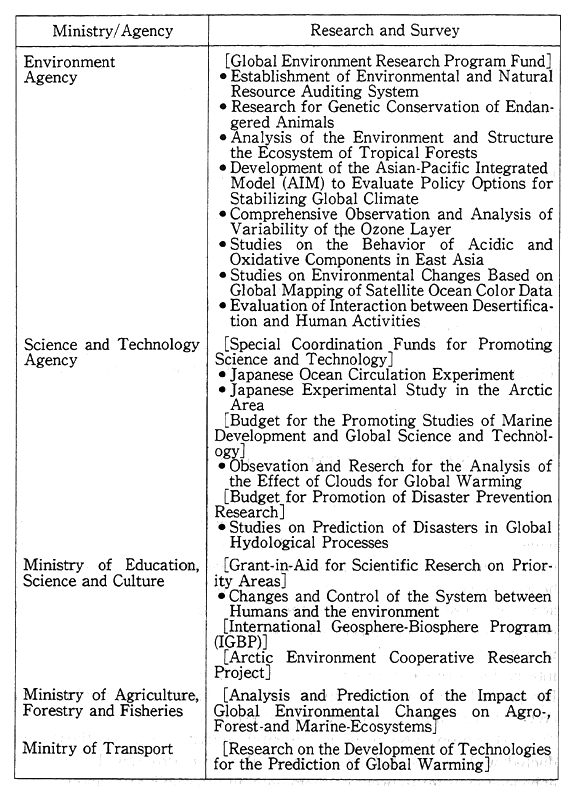
(2) Promotion of Technology Development
There is a need for technological development to mitigate global environment changes and to facilitate sustainable development, including technologies to deal directly with the treatment and reduction of pollutants and to promote the efficient use of resources and energy. It should be ensured, when developing technology to arrest global environmental problems, that it must not cause other environmental problems. It is also important to promote development of technologies that are suitable for the natural and social conditions of the developing countries.
From these standpoints, the efforts to develop technologies necessary for international responses to such problems as global warming, depletion of the ozone layer, acid precipitation, marine pollution. tropical deforestation, and desertification have been promoted, and research and development structures have been strengthened.
Major technological development during fiscal 1993 are shown in Table 12-5-2
Table 12-5-2 Major Technology Developments in the Fields to Global Environment in FY 1993

12-5-2 Monitoring and Surveillance of the Global Environment
Global environmental monitoring and surveillance include various areas, items, fields, and measures. Thus these activities were performed while taking part in and coordinating with some international monitoring programs, such as the UNEP Global Environment Monitoring System (GEMS). the WMO Global Atmosphere Watch (GAW), and the WMO/IOC All-World Integrated Global Ocean Services System (IGOSS). The results and data were mutually exchanged among related institutions.
Table 12-5-3 Major Monitoring and Surveillarice Activities in the Field of Global Environment in FY l993
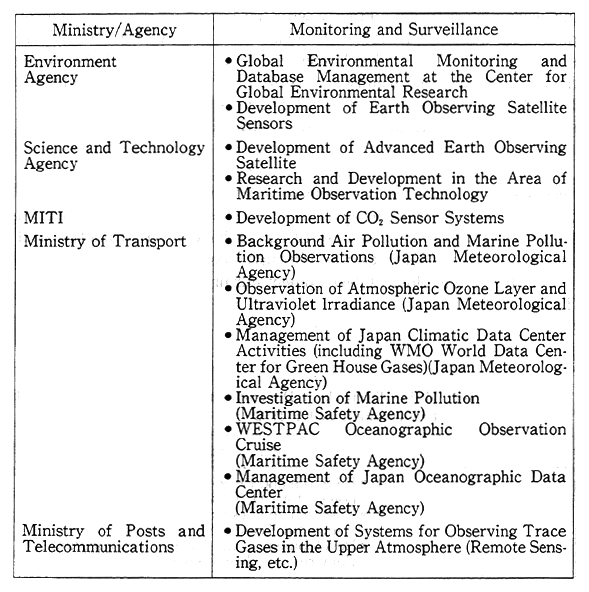
Furthermore, because of the needs for monitoring on a global scale, the development of effective measurements, such as satellite instruments, were actively promoted.
To measure concentrations of greenhouse gases, a new monitoring station has been established at Rakuseki Cape in Hokkaido. In addition, the measurement of greenhouse gases has been improved at the standard monitoring station for the GAW/Background Air Pollution Monitoring Network (BAPMoN) on Minamitori (Marcus) Island, and the measurement of the ozone layer has started.
Major monitoring and surveillance activities conducted in 1993 include those shown in Table 12-5-3.
12-6 Overseas Public Information
Japan has accumulated a wealth of experience and superor technologies in the field of environmental protection and as the country has assumed an increasingly important role in international society, its responses to environmental issues have garnered much attention overseas.
Therefore, by offering to various nations information and perspectives gained through the Japan's experience with pollution and efforts to resolve such problems. Japan can promote a deeper understanding of its policies and make a significant contribution to the international community.
To this end, the Environment Agency issues a number of Englishlanguage publications regularly, including Quality of the Environment in Japan, Environmental Research in Japan. Global Environment Research of Japan and Japan Environment Summary. The Agency also prepares overseas public information materials and distributes these to various governments, international organizations, researchers and academics, and members of the press. In addition, with the cooperation of regional government bodies, the Agency sponsors international symposiums to follow up on global summits and undertakes other intensive public information activities.
Chapter 13. Surveys and Research on Environment Protection
13-1 Research and Promotion Activities by the National Institute for Environmental Studies
13-1-1 Strengthening the Research System
The National Institute for Environmental Studies (NIES), established in March 1974 in Tsukuba Science City, was reorganized in July 1990, in order to incorporate natural and global environment conservation into the domain of its research and to reinforce research associated with both global and local environments. The Environmental Training Institute, formerly known as the National Environmental Training Institute (NETI) located in Tokorozawa in Saitama, was merged into NIES, as the national center for environmental training. Furthermore, in October 1990, the Center for Global Environmental Research (CGER) was established within NIES to support studies on the global environment and to promote global environmental monitoring.
In fiscal 1993, a research team to study environmental health. problems. in developing countries was established in the NIES Regional Environment Division. In addition, in order to promote research on applications of recently developed biotechnology to environmental preservation, the Environmental Biotechnology Laboratory was completed in October 1993.
At the end of fiscal 1993, NIES had 275 regular employees organized into two project research divisions, six fundamental research divisions, and three centers and administrative sectors.
13-1-2 Research Activities
(1) Research Work
In fiscal 1993, studies were made on 150 fundamental subjects, on 9 special projects, and on 44 projects supported by the Global Environment Research Program of the Environment Agency of Japan. The special projects in fiscal 1993 were as follows :
(a) Multiplier effects of chemical pollutants at ecosystem level in aquatic environrnents
(b) Studies of systems and environmental conservation in enclosed coastal seas
(c) Application of biotechnology to preservation of the environment and evaluation of its effects
(d) Characteristics of wetland ecosystems and their stability against environmental changes
(e) Human exposure to halogenated organic compounds and its health effects
(f) Lake environment indexes and nuisance picoplankton blooms
(g) Environmental health studies on stress and health effects due to environmental sounds and air pollution in highly urbanized areas
(h) Air and water pollution in an urban area caused by changes in the environmental load and countermeasures against it
(i) Evaluation of the risk of chronic pulmonary diseases due to diesel exhaust exposure and mechanism of pathogenesis
(2) Environmental Information Service
The Environmental Information Center (EIC) has been developing environmental databases such as those for air and water quality and the General Reference System for the Natural Environment. EIC has also managed to expand reference data by collecting books and other materials on the environment from foreign countries as well as Japan.
EIC continues to serve as the Japanese national focal point of the Global Environmental Information Exchange Network (INFOTERRA, formerly International Referral System for Sources for Environmental Information) of the United Nations Environment Programme (UNEP).
In fiscal 1993, in order to increase public access to environmental information, NlC built a Guide to Environmental Information Sources (EI-GUIDE), which was a compilation and directory of the sources of environmental information with a hyper-text-like linkage system.
(3) Support for Global Enviromnental Research
With the aim of reviewing the future strategy for global environmental research, the Center for Global Environmental Research (CGER) held or sponsored a number of meetings and conferences, including the Tsukuba Ozone Workshop--Global Environment Tsukuba '94, a research conference on the global carbon cycle and the missing sink, and the Intergovernmental Panel on Climatic Change (IPCC) Workshop on Policy Instruments and Their Implications.
CGER has been acting as one of the Global Resource Information Database (GRID)/UNEP nodes and upgrading its in-house global environmental database.
CGER'S Supercomputer system, equipped in fiscal 1991, has served to make various simulations concerning global changes, including global warming. A workshop on global environmental research using the CGER'S supercomputer was held and CGER'S Supercomputer Activities Raport 1993 was published in English.
(4) Global Environmental Monitoring
Continuing its activities from the previous year. CGER conducted various global environmental monitoring activities. The measurements included : (a) greenhouse gases (GHGs) and other related atmospheric constituents at Monitoring Station-Hateruma, located in Okinawa Prefecture ; (b) stratospheric ozone layer by ozone laser radar at NIES ; (c) nutrients and chlorophyll in the western Pacific by a ship of opportunity ; and GHGs over Siberia by aircraft. A data handling system for sensors that will be installed on the Advanced Earth Observing Satellite (ADEOS) has been under development. To reveal the trend in urban ultraviolet-B (UV-B) solar radiation resulting from stratospheric ozone depletion, a Brewer spectrophotometer was installed at the top of a building in Tokyo. and monitoring has been conducted since November 1993.
13-2 Surveys and Research on Environmental Conservation
13-2-1 Ongoing Surveys and Research
Scientific and technological research for promoting environmental conservation can be categorized into five main fields ; developing technologies to prevent pollution and other public hazards ; developing surveillance and measuring technologies; understanding and appraising the effects of environmental pollution ; elucidating environmentai pollution mechanisms; and plreserving the natural environment .
At present, research activitiee are under way in a broad range of related areas, under the auspices of the national and local governments and the private sector.
To promote progress in these research activities, it is necessary for the national government to achieve close coordination among the related research institutions and researchers since the relevant areas of science and technology are broad and the research fields are closely linked with one another. To facilitate coordination of these activities, the full amount of funds to cover the costs of research related to environmental pollution prevention and related topics undertaken by all relevant ministries and agencies and other institutions (excluding funds for research under the jurisdiction of universities and their research organizations) are allocated in a lump sum to the Environment Agency budget. Through distribution of these funds, the Agency works to achieve overall coordination of all research related to pollution prevention sponsored by the national government. The Agency also is able to implement research which forms the basis for national policies that set standards and to undertake research using the resources of the Coordination Fund for Encouragement of Comprehensive Surveys and Research for Conservation of the Environment to deal effectively with emergencies when they arise.
To promote the development of large-scale and comprehensive technologies for which there is a significant governmental administrative need or to implement major technological breakthroughs that eliminate or significantly reduce pollution, large-scale projects are organized including participants from the private sector and measures are implemented to provide subsidies for this purpose to the private sector.
The environmental testing and research institutes of local governments carry out surveys and research which are closely tied in with the environmental administration of their respective areas. The Environment Agency continues to implement measures to support such activities.
13-2-2 Environmental Research and Studies by National Institutions
(1) Outline
The funds appropriated in a lump sum to the Environment Agency for environmental research and studies by national institutions in fiscal 1993 totalled ¥1,918.04 million and these funds were allocated to 91 research themes (¥1,918.04 million and 92 themes in fiscal 1992). This research was conducted by 46 research organizations belonging to 12 ministries and agencies : the Hokkaido Development Agency, the Science and Technology Agency, the Environment Agency, the Ministry of Finance, the Ministry of Education, the Ministry of Health and Welfare, the Ministry of Agriculture and Forestry, the Ministry of International Trade and Industry, the Ministry of Transportation, the Ministry of Posts and Telecommunications, the Ministry of Labor, and the Ministry of Construction.
Using this funding for environmental research and studies, efforts have continued to organize and promote comprehensive research projects in each research area with consideration given not only to immediate problems but to the development of the bases for policy measures from a long-term perspective.
(2) Comprehensive Research Projects
In fiscal 1993, 10 comprehensive research projects were carried out as listed below .
(a) Research on air pollution prevention
In addition to conducting research on 15 themes related to the development of technologies to prevent air pollution from the discharge of substances from various sources and to monitor such pollution, new research began on four themes, including high efficiency catalytic combustion in small-scale combustion engines and reduction of NOx emissions.
(b) Research on increasing the sophistication of effluent treatment
In addition to conducting research on five themes related to the use of chemical and biological technology to treat and dispose of industrial and household effluents, a new research project began on the development of yeast strains, developed through recombinant gene technology, in the processing of wastes.
(c) Research on marine pollution prevention
In addition to work on 10 research themes, including elucidation of the phenomenon of ocean pollution and the development of technology for the prevention of pollution and purification of the oceans, research is being conducted on two new themes, including the purification of oil-polluted waters through the use of microorganisms.
(d) Research on land water pollution prevention
Research is being conducted on seven themes related to the development of technology for the prevention of pollution and related to technology for purification of land water.
(e) Research on the treatment of wastes and recycling technology
In addition to conducting research on six themes related to technology for the harmless disposal of waste and technology for recycling, research was conducted on three new themes related to the restriction of harmful substances released through the incineration of industrial waste.
(f) Research on the management and conservation of the natural environment
In addition to conducting research on six themes related to the development of management methods for the natural environment, new research projects began on the conservation of and management methods for the ecologies of marshes and wetlands.
(g) Research on the development of methods for the preservation of the urban environment
In addition to conducting research on technologies for the appraisal of the urban environment and application of technologies, research began on two new themes related to technologies to create habitats for plants and animals living around bodies of water.
(h) Research on the prevention and assessment of noise and vibratian
Regarding noise and vibration, research is, being conducted on four themes : technology to prevent noise at its source, technology to reduce the transmission of vibrations and sounds, technology for measurement, and methods to forecast and assess the effects of such noise and vibration on health.
(i) Research to increase the sophistication of monitoring technology for environmental pollutants .
In addition to. conducting research on seven themes, including methods to monitor environmental pollutants and technologies for monitoring a broad geographic area, research began on three new themes, including the development of sophisticated methods for detecting traccs of lubricating oil.
(j) Research to assess the effects of environmental pollutants
Research was conducted on eight themes, including the methods to safely assess the genetic, physiological, and biological effects of environmental pollutants. New research projects began on three new themes, including water pollution monitoring methods that use an index of the poisonous impact of pollutants on the cellular genetic makeup of aquatic organisms.
In atddition to the 1O comprehensive research projects noted research was conducted on two themes related to technologies for calculating an environment-related index for prior assessment of the effects of chemical substances on the environment. Furthermore, regarding regional environmental problems, local public research institutes, and national res,earch institutes conducted cooperative research projectst-Cooperation Research on Regional Environment--to elucidate the mechanisms of underground water pollution in areas with heavy snowf all.
13-2-3 Surveys and Research with Budget for Promotion and Coordination of Comprehensive Surveys and Research for Environment Conservation
The main surveys and research carried out in fiscal 1993 by the Environment Agency with funds from the Budget for Promotion and Coordination of Comprehensive Surveys and Research for Environment Conservation were as follows : surveys related to the methods and implementation of the Basic Environmental Plan ; emergency surveys overseas under the Environmental Impact Assessment System ; surveys on the damage to plant life and scenery from the proliferation of Ezo deer in Akan National Park ; emergency surveys on the damage to the coral reefs due to varieties of crown of thorn starfish in Amakusa region of Unzen National Park ; surveys on the effects of hunting wildlife on the environment ; emergency surveys conducted to assess the polluting effects of nitric acid and other substances in fresh water supplies ; urgent surveys on trees that are withering in the mountainous regions of the Nikko National Park ; studies on suitable methods to manage the water basins where lakes and marshes cover parts of several prefectures ; emergency studies on the causes of the death of plant life formerly growing in abundance in rocky coastal areas in Hokkaido ; and studies to estblish a system to confirm measurements of methane gas discharged. Furthermore, the Ministry of Agriculture. Forestry and Fisheries conducted research related to controlling the growth in the Ogasawara area of the Akagi tree, which is not indigenous to Japan. The Ministry of International Trade and Industry conducted studies on the prevention of pollution from waste water containing artificial dyes. The Ministry of Transport conducted research on the emission and treatment of bilge and other effnuents from ships containing oil and carried out an investigation related to safety measures for tanker transportation. The Environment Agency, the Ministry of Finance, and the Ministry of Agriculture, Forestry and Fisheries conducted joint research on the processig, disposal, and recycling of high-density organic fluids for which disposal at sea is forbidden.
13-2-4 Surveys and Research under the Budget for Surveys and Research to Prevent Environment Pollution
To Contribute to setting various standards and related matters, the Environment Agency makes use of funds from the Budget for Surveys and Research on the Prevention of Environmental Pollution, to conduct rescareh and surveys on the effects of environmental pollution on health ; develop technologies to measure various types of pollutants ; and to clarify the mechanisms of environmental pollution. In fiscal 1993, a new study began on the impact of agricultural chemicals on wildlife,
In addition, to preserve the natural environment, in fiscal 1993, studies were conducted on measures to preserve the natural scenery of farmlands and pasture lands in natural scenic areas.
13-2-5 Other National Government Research and Subsidization of Research in Japan
The Ministry of Transport carried out research in areas where demand is high for the improvement of the environment, such as purifieation technology to improve water quality in enclosed bodies of water and canals as well as sophisticated technology to improve the ocean environment.
The Ministry of Construction conducted research projects to develop contruetion technology for national land development which conserves resources and energy : to control the level of constructionrelated by-products ; to develop technologies for the recycling and reuse of such by-products and wastes; and to develop basic technology for promoting greening of the environment.
The Ministry of Agriculture, Forestry and Fisheries continued to conduct studies on developing an agricultural system that is in harmony with the environment and makes use of the sophisticated materials recycling functions of agricultural ecologies. Moreover, the Ministry has expanded its research to elucidate _the dynamics of greenhouse gases ; to develop control technologies making use of the agricultural, forestry, and fishery ecologies ; and to elucidate the impact of changes in the environment on agricultural, forestry, and fishery activities.
The Ministry of Education promoted a wide range of basic research on the preservation of the environment undertaken by university researchers, and encouraged other researchers to study areas related to environmental preservation. In addition, within priority areas specified for the Scientific Research Subsidy Budget, four areas were identified relating to the linkages between changes in the earth's environment and the rise and fall of civilizations. In addition, research was also promoted in general categories.
The Ministry of Posts and Telecommunications conducted research on technology to study the middle stratosphere making use of high intensity electromagnetic waves and on two-frequency Doppler radar to observe rainfall from space.
The Science and Technology Agency used funds from the National Institute's Atomic Energy Testing and Research Budget to conduct basic research related to environrnent policy, making use of radioisotopes, including studies of highly sensitive methods to detect the impact of environmental pollution at the genetic level.
13-2-6 Environmental Research by Local Governments
The environmental research institutions of local governments play a role in supporting environmental administration by providing scientific information ; extensively monitoring and measuring, analyzing, surveying, and gathering basic information ; and actively promoting research on regional environmental problems.
In 1993, to insure close communication and to promote effective cooperative research efforts among environmental , researchers and institutions of local governments, the Environment Agency convened a meeting attended by the directors' of these Local institutions. Furthermore, to promote exchange of information between researchers, an environmental preservation and protection conference was heId in Hiroshima to explain the latest results of surveys and studies from environmental research institutions of local governments. In. addition, the National Institute for Env:ironmental Studies carried out joint researoh on 55 subjects with 30 Iocal environmental experiment and research institutions in fiscal 1993.
Chapter 14. Other Environmental Administration
14-1 Upgrading the Precision of Environmental Monitorin and Analsis and Related Issues
14-1-1 Upgrading the Precision of Environmental Monitoring and Analysis
In order to contribute to promoting the precise implementation of all types of measurement and analysis, which forms the basis of inspection for environmental pollution survey research, a standardized administrative environmental monitoring and analytical survey was carried out.
A survey on the condition of the precision of environmental monitoring and analysis was carried out. The substantial problems posed for the execution of environmental monitoring and analysis were also surveyed. This survey is so designed that uniformly adjusted environmental materials are forwarded to environmental monitoring and analysis institutions (more than 400) across the nation to survey relations among the findings of the analysis, previously processed conditions and conditions far the use of monitoring equipment, and other sub,stantial problems for the execution.
In fiscal 1993, surveys were conducted on six heavy metals -cadmium, lead, nickel, chrome, arsenic, and selenium-and three agricultural medicines in simulated environment water samples.
14-1-2 The Establishment of Standards for Measurement Methods
While working toward expanding the application of Japanese industrial standards with regard to methods of analyzing contaminating materials and automated monitoring equipment based on the Ministry of Trade and Industry (MITI)'s Industrial Standardization Law, survey research was carried out on standard liquids and on low concentrations of standard gases used in monitoring pollution along with surveys of standard materials which form the foundation for this survey research.
14-2 Training Government Officials in Charge of Environmental Protection
In order to promote effective environmental administration, it has become important to gather materials and strive to raise the capabilities of the government officials in charge of environmental protection in public bodies at the national and local levels. For this reason, the Environment Agency of Japan established the National Environmental Training Institute (NETD in March 1973. NETI was reorganized in July 1990 as the National Institute of Environmental Studies and is working to expand its training program to take into account every form of environmental protection, directing these programs toward officials in national and regional public bodies.
By the end of fiscal 1992, a total of 21.017 officials (of whom 17. 184 were from administrative departments and 3,833 were from laboratories) had been trained at the Institute.
In fiscal 1993, in response to the demand for global environmental preservation and international environmental cooperation, programs to educate trainees who are officials in charge of training in developing nations and programs connected with technology for global environmental preservation were newly established. This agency is planning a thorough examination of the effectiveness of its existing training courses and, while continuing to take account of the demand for the development , of environrnental administration and requirements of regional public bodies, is working to continuously improve its courses and offer a wide variety of administrative and analytical training.
14-3 Health Measures in Schools
The Ministry of Education carried out the following measures to promote public health :
a. Projects to promote the greening of the school environment
To raise the learning abilities of pupils at all public compulsory education schools in areas with regional air pollution, and to strive to aggressively promote the health of mind and body, the Ministry of Education assists with a portion of the necessary expenses of local public bodies, which in fiscal 1993. were budgeted at ¥168,840 thousand.
b. Projects for the promotion of nature classes
To develop the sound minds and bodies of elementary and junior high school pupils, ¥693,900 thousand in subsidies was paid in fiscal 1993 to the nature class project of schools and local public bodies, in which pupils were educated through group outdoor stays in the natural environment.
c. Construction for prevention of environmental pollution at public schools
In fiscal 1993 a sum of ¥724 million was subsidized as expenses for the rebuilding of buildings polluted heavily and pollution-prevention construction.
d. Loans for pollution control
In fiscal 1993 an amount totaling ¥500 million was loaned by the Japan Foundation for the Promotion of Private Schools for such projects as construction to soundproof private schools.
e. Projects for the proxnotion of young people's experience in nature
With the aims of environmental education, the sum of ¥l05 million was allocated to subsidize projects of prefectures and municipalities that promote nature activities such as long-term camping for young people in fiscal 1995.
14-4 Environmental Preservation Policies by Local Governments
Based on laws and regulations, local governments take direct responsibility for the monitoring, measurement, and control of environmental pollution as it relates to environmental conservation. They also play a significant role in various projects combating environmental pollution and protecting nature.
Local government conservation measures are implemented comprehensively in accordance with the needs of local residents, as well as the local natural features, environmental conditions and socioeconomic trends. Many prefectures and cities have formulated local environmental management programs which promote local environmental conservation measures in a strategic and systematic manner. They are also engaged in the development of environmental information systems.
Moreover, along with giving consideration to the promotion and systematization of environmental impact assessments, the promotion of household wastewater disposal policies and the implementation of such other policies as those concerning noise pollution, the promotion of greening, preserving greenery through a land trust system, creating a pleasant environment, and recycling are being implemented.
To implement these policies in fiscal 1993, a number of fiscal measures were taken and regional government budgets contained expenses for environmental preservation policies as ¥200 billion.
14-4-1 Organizations and Officials in Charge of Environmental Administration
As of October 1, 1993, the number of staff in charge of environmental administration in prefectures, designated cities and other municipalities was 7.448. The number of full-time officials and the number of staff concurrently holding another position is shown in Table 14-4-1, categorized by the organization they belonged to. Furthermore, the number of employees responsible for the preservation of nature is 1,842, as shown in Table 14-4-2.
Next, as of October l, 1993, 233 towns and villages had a bureau and a division (office) that specialized in pallution problems, and in addition, 487 towns and villages had a subdivision (team) specializing in pollution problems. Municipalities having only full-time officials with exclusive responsibility far environmental pollution problems numbered 246. Taken together. these municipalities made up 29.8% of all municipalities. Moreover. 55 municipalities had branches in charge of pollution problems.
Table 14-4-1 Staff in Charge of Environmental Pollution in Prefectures and Designated Cities
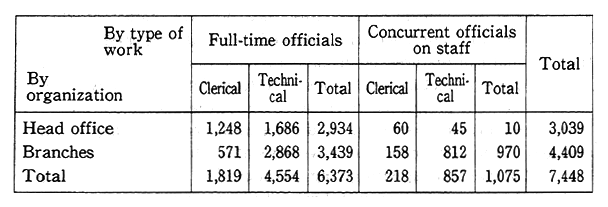
Notes : l. Survey by the Environment Agency.
2. Conictirrent officials on staff are those in charge of two or more lines of administrative work on environmetal tasks. The number is based on estimates of the volume of their work
3. The number of officials on staff who deal with garbage disposal and sewerage systetms is excluded.
Table 14-4-2 Staff in Charge of Nature Conservation in Prefectures and Designated Cities
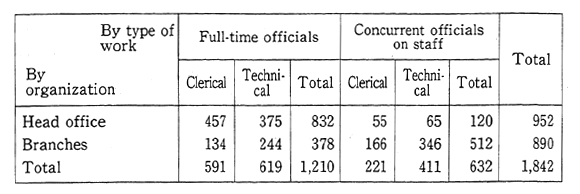
Notes : l. Survey by the Environment Agency. 2. Concurrent officials on staff are those in charge of two or more lines of administrative work on environmental tasks. The number is based on estimates of the volume of their work.
Additionally, as of October 1, 1993, the number of specialized personnel in municipalities with responsibility for environmental pollution was 4,907. A breakdown of these personnel by type of organization is shown in Table 14-4-3.
Table 14-4-3 Full-Time Officials on Staff in Charge of Environmental Pollution Problems in Municipalities
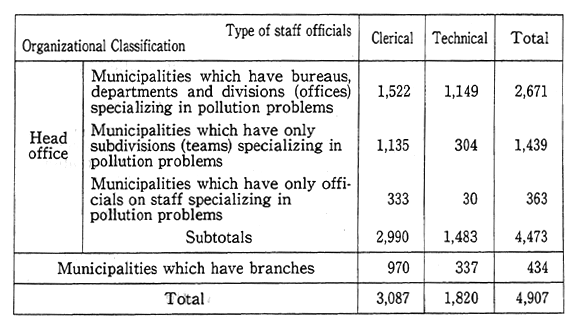
Notes : 1. Survey by the Environment Agency. 2. The number of officials on staff in charge of garbage disposal and sewerage systems is excluded.
14-4-2 Local Enactment
Local government laws for environmental conservation are instrumental in comprehensively promoting substantial local environmental conservation measures. They may be classified into four areas : (1) laws for pollution control, (2) law for environmental conservation. (3) law for conservation of natural environment, and (4) other laws for environmental conservation (including the law on environmental impact assessments). The current state of the enactment of those is as follows :
Laws related to environmental conservation show the basic stances of regional governments (prefectures and designated cities). As of October l, 1993, 54 organizations had enacted laws for the prevention of environmental pollution. As of October l, 1993, ll prefectures and designated cities had enacted laws for overall environmental conservation. By enacting laws for conservation of the natural environment, regional governments provide basic guidelines for nature conservation. Also, as of October l, 1993, 48 regional government and designated cities had enacted such decrees.
Other laws related to environmental conservation include those on environmental impact assessments, on natural parks, on measures to control studded tires, prevention of lake and reservoir eutrophication, for greening, and appropriate disposal of empty cans. Acts related to environmental conservation enacted by municipalities are shown in Table 14-4-4.
Table 14-4-4 Enactment for Environmental Conservation by Municipalities

14-4-3 Conclusion of Environmental Pollution Prevention Agreements
During the period from October 1992 to September 1993. the number of pollution prevention agreements made was about 2,200, and at September 30, 1993, the number of such agreements in effect was about 42,000.
Moreover, in recent years, concern has been voiced from all quarters that golf courses are causing environmental preservation problems. As of September 30, 1993, about 1,800 environmental protection agreements related to golf courses had been concluded and were in effect.
The following may be cited as reasons for the conclusion of agreements on preventing environmental pollution : (1) By using pollution prevention agreements it is possible to implement in an appropriate way finely tuned pollution prevention policies that meet the needs of the appropriate authorities in regional societies and respond to the local geographic and social conditions. (2) Businesses become aware that, in locating a factory, the consent of local residents regarding the selected site is essential for achieving smooth startup and operation.
By industry, parties to the concluded agreements are shown in Table 14-4-5. The same agreements are categorized in Table 14-4-6 by type of preventative measure taken regarding environmental pollution. The number of environmental pollution prevention agreements to which residents are parties or witnesses is indicated in Table 14-4-7.
Table 14-4-5 Number of the Newly Concluded Environmental Pollution Prevention Agreements, by Industry
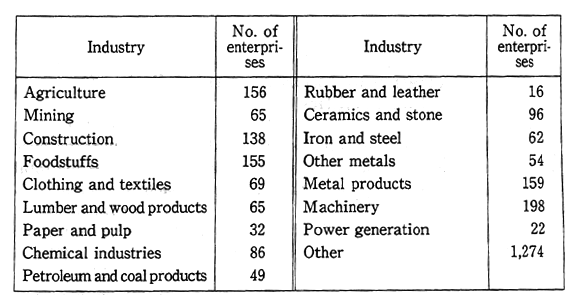
Notes :1. Environment Agency Survey.
2. Data is for agreements concluded during the period from October 1, 1992, to September 30, 1993
Table 14-4-6 Pollution Prevention Agreements by Type of Preventative Measure

Notes : 1. Environment Agency survey. 2. Data shows the agreements concluded for the year from October , 1992, to September 30, 1993.
Table 14-4-7 Citizen Participation in Pollution Prevention Agreements

Notes : 1. Environment Ageney survey 2. Data shows the agreements concluded from October 1, 1992, to September 30, 1993.
14-4-4 Subsidization of Environmental Pollution Prevention Facilities
The number of loans provided by local governments themselves for environmental pollution facilities in 1992 was 1,300, and the total amount of these loans was ¥178 billion (Table 14-4-8).
Table 14-4-8 Local Government Loan Program for Pollution Control Investment (Fiscal 1992)

Note : Environment Agency survey. Prefectural governments include administrative ordinance-designated cities, and municipalities include Tokyo's 23 wards.
Table 14-4-9 Local Government Subsidy Programs for Pollution Control Investment (Fiscal 1992)

Note : Environment Agency Survey. Prefectural governments include administrative ordinance-designated cities, and municipalities include Tokyo's 23 wards.
14-4-5 Outlays for Environmental Pollution Measures
In fiscal 1992, local government outlays for antipollution measures (including those by local government-managed businesses) came to ¥4,968 billion ¥1,244.3 billion for prefectural governments and ¥3, 723.7 billion for municipalities). This was an increase of ¥811.7 billion, or 19.5%. Over the previous fiscal year ¥124.8 billion for prefectural governments, and ¥686.9 billion for municipal governments (Table 14-4-lO).
Looking at the expenditures by category of pollution control measures, operating expenses for pollution prevention were ¥4,580.2 billion (92.2% of the total), followed by general expenses of ¥146.7 billion (3.0% of the total).
Table 14-4-10 Statements of Account for Municipal Pollution Measures (Fiscal 1992)
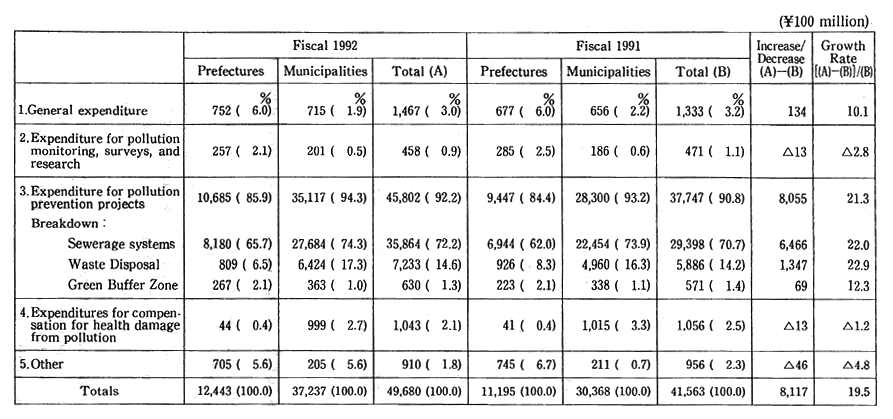
Note : Duplications in subsidies, expepses, etc., between prefectures and municipalities have been eliminated from these statements of account.
Operating expenses for pollution prevention by category include ¥3,586.4 billion for operating expenses for upgrading sewage treatment facilities, at 72.2% of expenditures_ and the highest single percentage, followed by operating expenses for waste management equipment at ¥723.3 billion (14.6% of the total).
14-5 Equipping the Private Sector with Environmental Pollution Prevention Systems
14-5-1 Implementing Pollution Prevention and Management Systems in Industry
To establish pollution prevention systems in factories, in June 1971 the Law Concerning Pollution Prevention Organizations in Specified Factories came into effect, and since September 1972, specified factories have been required to assign environmental pollution controllers, environmental pollution prevention managers, and other staff with special knowledge and skills. About 20.000 specified factories work to establish internal organizations for pollution prevention.
With regard to the selection of pollution prevention controllers, according to prefectural surveys, at the end of March 1993 there were about 24,000 pollution prevention controllers (including their deputies) and about 40,000 pollution prevention managers (including their deputies) in Japan.
Moreover, under the same law, a national examination and a lecture course for certification were started in order to train qualified pollution prevention managers. There are now 430,691 qualified individuals in Japan.
(1) National Examination for Pollution Prevention Managers
The Ministry of International Trade and Industry (MITI) has carried out a national pollution prevention managers' examination annually since fiscal 1971. The national examination in 1993 was carried out on September 26 and October 3 ; the number of people applying for the test was 25,342 ; and 20,866 took the test. Of these, 4,589 passed. Further, by fiscal 1993, those who had passed the national examination numbered 233,807.
(2) Certification Lectures for Qualifying Individuals
In order to become qualified as a pollution prevention manager other than through the examination stated above, candidates may also complete the lecture course for certification. This system is for those who possess certain technical qualifications or practical experience relating to pollution prevention. Those who undergo training and complete the lecture course will be granted the same kind of qualification as those who passed the national examination. The number of trainees who had completed. the certification lecture course by fiscal 1993 was 196, 884.
14-5-2 Improvement of Environmental Monitoring in the Private Sector
(1) The Ministry of International Trade and Industry (MITI) carried out a thorough revision of environmental monitoring methods, and these new methods were instituted and officially announced on May 20, 1992. These methods then went into effect on November 1, 1993, and they affected pollution monitoring devices including flow meters, noise meters, vibration level meters, and density meters. The manufacturers of these devices were required to notify businesses of the new regulations and conduct inspections of their use.
In addition, the businesses that are conducting verification of environmental measurement must be registered with the prefectural governor, and the inispection of measuring devices used in measuring the evidence of pollution is mandatory.
(2) Businesspeople engaged in monitoring densities, noise levels, and , so on that is, people in business engaged in gathering quantitative data on the environment, are obliged to register as private persons serving in the capacity of quantitative environmental inspectors. The certified environmental inspector system was set up in 1974, and those who finish the prescribed lecture course and pass the national examination are registered with the Minister of International Trade and Industry. The number of registrants reached 6,979 as of the end of November 1993.
In addition with regard to the certified environmental inspector system, due to recent revisions of the law, pollution measurement activities are separated into two types : density and noise level/vibration.